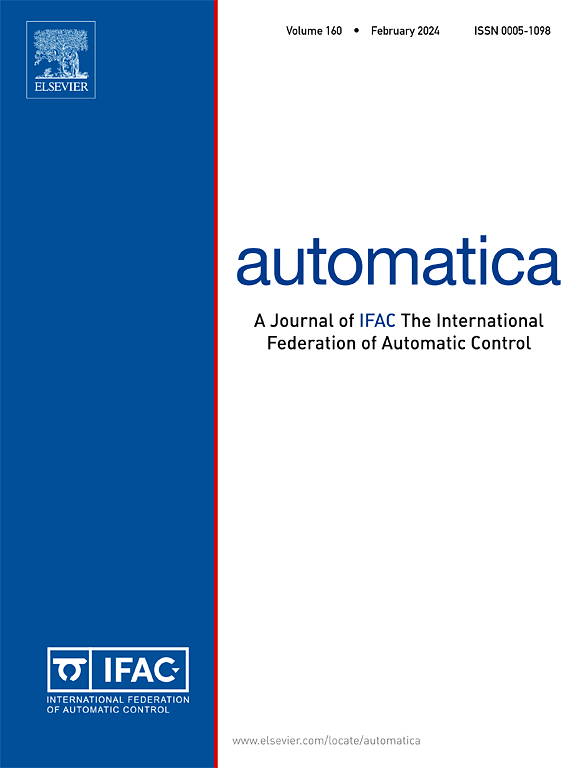Safe delay-adaptive control of strict-feedback nonlinear systems with application in vehicle platooning
IF 5.9
2区 计算机科学
Q1 AUTOMATION & CONTROL SYSTEMS
引用次数: 0
Abstract
This paper presents a safe delay-adaptive control for a strict-feedback nonlinear ODE with a delayed actuator, whose dynamic is also a strict-feedback nonlinear ODE and the delay length is unknown. By formulating the delay as a transport PDE, the plant becomes a sandwich configuration consisting of nonlinear ODE-transport PDE-nonlinear ODE, where the transport speed in the PDE is unknown. We propose a predictor-based nonovershooting backstepping transformation to build the nominal safe delay-compensated control, guaranteeing that the output of the distal ODE safely tracks the target trajectory from one side without undershooting. To address the uncertainty in the delay, we incorporate recent delay-adaptive and safe adaptive technologies to build a safe adaptive-delay controller. The adaptive closed-loop system ensures (1) the exact identification of the unknown delay in finite time; (2) the output state stays in the safe region all the time, especially in the original safe region, instead of a subset, after a finite time; (3) all states are bounded, and moreover, they will converge to zero if the target trajectory is identically zero. In the simulation, the proposed control design is verified in the application of safe vehicle platooning. It regulates the spacing between adjacent vehicles to converge to a small distance and avoids collisions by ensuring they do not breach the safe distance at any time, even in the presence of large unknown delays and at a relatively high speed.
严格反馈非线性系统的安全延迟自适应控制及其在车辆队列中的应用
本文提出了一种具有延迟执行器的严格反馈非线性非线性微分方程的安全延迟自适应控制,该微分方程的动态也是一个延迟长度未知的严格反馈非线性微分方程。通过将延迟表述为传输PDE,工厂成为由非线性ODE-传输PDE-非线性ODE组成的夹层结构,其中PDE中的传输速度是未知的。我们提出了一种基于预测器的非超调后推变换来构建名义安全延迟补偿控制,保证远端ODE的输出安全地从一侧跟踪目标轨迹而没有欠冲。为了解决延迟中的不确定性,我们结合了最新的延迟自适应和安全自适应技术来构建一个安全的自适应延迟控制器。自适应闭环系统保证(1)在有限时间内准确识别未知延迟;(2)输出状态在有限时间后一直停留在安全区域,特别是在原安全区域,而不是一个子集;(3)所有状态都是有界的,并且当目标轨迹为同零时,它们收敛于零。仿真结果验证了所提出的控制设计在车辆安全队列中的应用。它调节相邻车辆之间的间距,使其收敛到较小的距离,并确保它们在任何时候都不会超出安全距离,即使在存在较大未知延迟和相对较高的速度下也不会发生碰撞。
本文章由计算机程序翻译,如有差异,请以英文原文为准。
求助全文
约1分钟内获得全文
求助全文
来源期刊

Automatica
工程技术-工程:电子与电气
CiteScore
10.70
自引率
7.80%
发文量
617
审稿时长
5 months
期刊介绍:
Automatica is a leading archival publication in the field of systems and control. The field encompasses today a broad set of areas and topics, and is thriving not only within itself but also in terms of its impact on other fields, such as communications, computers, biology, energy and economics. Since its inception in 1963, Automatica has kept abreast with the evolution of the field over the years, and has emerged as a leading publication driving the trends in the field.
After being founded in 1963, Automatica became a journal of the International Federation of Automatic Control (IFAC) in 1969. It features a characteristic blend of theoretical and applied papers of archival, lasting value, reporting cutting edge research results by authors across the globe. It features articles in distinct categories, including regular, brief and survey papers, technical communiqués, correspondence items, as well as reviews on published books of interest to the readership. It occasionally publishes special issues on emerging new topics or established mature topics of interest to a broad audience.
Automatica solicits original high-quality contributions in all the categories listed above, and in all areas of systems and control interpreted in a broad sense and evolving constantly. They may be submitted directly to a subject editor or to the Editor-in-Chief if not sure about the subject area. Editorial procedures in place assure careful, fair, and prompt handling of all submitted articles. Accepted papers appear in the journal in the shortest time feasible given production time constraints.
 求助内容:
求助内容: 应助结果提醒方式:
应助结果提醒方式:


